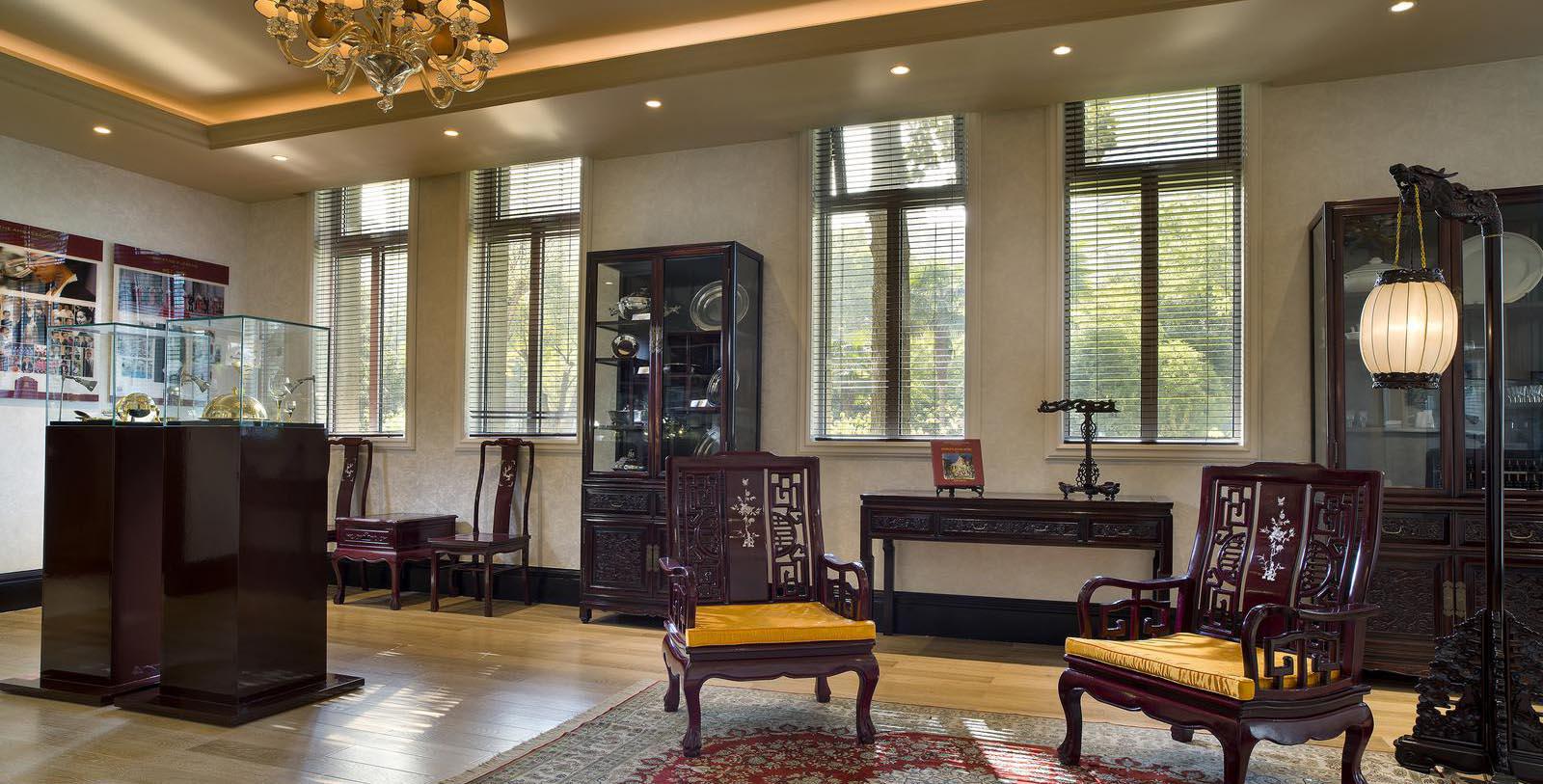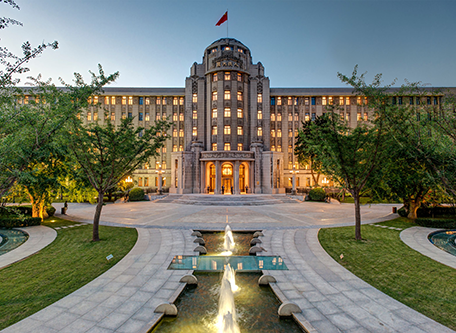Receive for Free - Discover & Explore eNewsletter monthly with advance notice of special offers, packages, and insider savings from 10% - 30% off Best Available Rates at selected hotels.
history
Discover the Sofitel Legend People’s Grand Hotel Xian, which has been among Xi’an’s most renowned destinations since the early 1950s.
Sofitel Legend People’s Grand Hotel Xian, a member of Historic Hotels Worldwide since 2018, dates back to 1951.
VIEW TIMELINEA member of Historic Hotels Worldwide since 2018, The Sofitel Legend People’s Grand Hotel Xian is located in the ancient city of Xian. In 1951, the land upon which the current hotel stands was designated for the State Guesthouse of Xian. Construction commenced immediately thereafter and lasted for two years. Designed by Chief Architect of the Northwest Institute of Architectural Design, Hong Qing, the hotel’s iconic building was influenced by French, Sino-Russian, and Art Deco architecture styles. The hotel’s design features a number of French details, including fleur-de-lis motifs throughout the hotel, as well as the Art Deco characteristics of spacious rooms, lofty ceilings, and extravagant moldings, and reliefs. While creating the hotel, Qing desired to accentuate the grounds of the former Imperial Palace. Continuing this tradition today, the hotel features 40,000 sq. m. of lush gardens with over 10,000 trees and plants and 4,000 birds amid Xian’s urban metropolis. Among the thousands of plants are 12 olive trees that were grown from seeds presented to the first Premier Zhou Enlai during an official government visit to Albania.
Over the past several decades, the hotel has come to be recognized as one of the city’s most important landmarks. As the only licensed State Guesthouse in Xian, the hotel was used solely by the government to house visiting foreign dignitaries, heads of state, celebrities, and other respected guests. Famous visitors to the hotel, such as Chinese Premier Zhou Enlai, U.S. Secretary of State Henry Kissinger, French President François Mitterrand, and even Queen Elizabeth II of the United Kingdom are catalogued in the original guestbook (currently on display inside the hotel’s private museum). In 2011, the hotel was acquired by AccorHotels and underwent major renovations for 28 months. Upon its re-opening in three years later, the new “Sofitel Legend People’s Grand Hotel Xian” was hailed as one of the best holiday destinations in all of China. It has since remained the top choice of international dignitaries and celebrities when traveling to Xian. This spectacular hotel continues to serve as one of the city’s best holiday destination, even receiving the “Best Room Design” from China Condé Nast Traveler in 2018.
-
About the Location +
Xian is a venerable city that has existed for thousands of years. The city itself emerged as the political center of China back in the 11th century with the founding of the Zhou dynasty. Despite the court’s relocation some four centuries later, Xian would periodically return to being an imperial capital 12 more times throughout its history. Following the tumultuous Warring States era, the Qin dynasty relocated the seat of power back to Xian upon reuniting China’s disparate warlords. To commemorate his rule, the first emperor, Qin Shi Huang, specifically constructed a magnificent Terracotta Army, as well as his mausoleum just to the east of the city’s contemporary borders. Many centuries later in 202 BC, the Han emperors established their own capital in the vicinity, calling Xian “Chang’an City.” They subsequently built their new settlement atop the ruins of the previous Qin administration. Shortly thereafter, Emperor Liu Bang constructed a spectacular residence—the Weiyang Palace—which was the largest structure of its kind built at the time. The historical fortified walls that still surround portions of modern Xian today also appeared during the reign of the Han emperors. Taking some four years to complete, the embattlements measured some 16 miles in length and were more than 50 inches in thickness in some places. The city itself had grown considerably, too, its population numbering around a million people by the end of the 3rd century AD. In fact, its size had become so massive that it rivaled that of ancient Rome and Baghdad. Nearly 100 wards comprised the city, separated by a series of gateways and major thoroughfares that measured hundreds of yards.
The Han emperors heavily regulated the local society, enforcing a strict curfew that demanded people stay inside their houses throughout the night. Humungous drums rang out every morning and evening, alerting the denizens of when to start and end their days. Historic Xian was nevertheless a prosperous city, given its location at the starting point of the fabled Silk Road. Two vibrant markets manifested in the city, as such, which saw countless merchants from across Asia trade a variety of goods. Despite Xian’s relative affluence under the Han emperors, the city entered into a true golden age during the reign of the Tang dynasty. The Tang era in general was one of progress and reform, as many historic Chinese inventions—ranging from gunpowder to gas stoves—emerged due to their patronage. Their influence throughout ancient Xian was no different. The city flourished exponentially thanks to the Tang, as dozens of new buildings debuted all across the landscape. (The Sofitel Legend People’s Grand Hotel Xian actually resides on the site of an official imperial Tang structure.) The emperors themselves even sponsored the creation of a new magnificent royal complex—the Daming Palace. Located near the heart of the historic downtown, the structure was a masterpiece of Chinese engineering. It featured three unique tired facilities consisting of an outer, middle, and inner court. Many beautiful administrative offices resided within the compound’s Xuanzheng Hall, including the Department of State Affairs, the Secretariat, and the Chancellery. The royal court gathered frequently at the stunning Zichen Hall, while grandiose banquets were often held at the neighboring Linde Hall.
When the Tang dynasty finally collapsed in the 10th century, Xian gradually lost its influence within Chinese politics. By the height of the Ming dynasty several centuries later, the city was nothing more than a regional capital. Still, Chinese officials sought to continuously improve upon Xian, inspiring a few Ming-era administrators to develop a new ring of fortifications around the city in the late 1300s. (The Ming also constructed two new edifices called the “Drum Tower” and the “Bell Tower” to replace the aging curfew stations.) Xian has since reemerged as one of China’s most culturally vibrant metropolises, especially after the country’s economic modernization in the 1980s. It is home to all sorts of facilities dedicated to technological research, national security, and even space exploration. But Xian is also a renowned tourist destination, attracting thousands of people from across the globe every year. Visitors today enjoy witnessing its many historical landmarks that chronicle China’s rich heritage. In fact, quite a few of the locations are even recognized as UNESCO World Heritage Sites. Perhaps the most popular are those that originate to the Tang dynasty, such as the Giant Wild Goose Pagoda and the Daming Palace Historic Site. Xian is even the location of an exciting Muslim Quarter that also dates back to the Tang dynasty. (The original inhabitants were merchants that had traveled along the Silk Road and decided to settle in the city.) Among the many fascinating sights to experience in the Muslim Quarter is the renowned Great Mosque of Xian. More iconic cultural attractions reside just beyond Xian, too, like the famous Terracotta Army at the Mausoleum of the First Qin Emperor.
-
About the Architecture +
Designed by Chief Architect of the Northwest Institute of Architectural Design, Hong Qing, the hotel’s iconic building was influenced by French, Sino-Russian, and Art Deco architecture styles. The hotel’s design features a number of French details, including fleur-de-lis motifs throughout the hotel, as well as the Art Deco characteristics of spacious rooms, lofty ceilings, and extravagant moldings and reliefs. Art Deco architecture itself is among the most famous architectural styles in the world. The form originally emerged from a desire from architects to break with past precedents to find architectural inspiration from historical examples. Instead, professionals within the field aspired to forge their own design principles. More importantly, they hoped that their ideas would better reflect the technological advances of the modern age. As such, historians today often consider Art Deco to be a part of the much wider proliferation of cultural “Modernism” that first appeared at the dawn of the 20th century.
Art Deco as a style first became popular internationally in 1922, when Finnish architect Eliel Saarinen submitted the first blueprints to feature the form for contest to develop the headquarters of the Chicago Tribune. While his concepts did not win over the judges, they were widely publicized, nonetheless. Architects in both North America and Europe soon raced to copy his format in their own unique ways, giving birth to modern Art Deco architecture. The international embrace of Art Deco had risen so quickly that it was the central theme to the renowned Exposition des Art Decoratifs in Paris a few years later. Architects the world over fell in love with Art Deco’s sleek, linear appearance defined by a series of sharp setbacks. They also adored its geometric decorations that featured such motifs like chevrons and zigzags. But in spite of the deep admiration people felt toward Art Deco, interest with the style gradually dissipated throughout the mid-20th century. Many examples of Art Deco architecture survive today, with some of the best located in such places like New York City, Chicago, London, Paris, and of course, Xian.
-
Famous Historic Guests +
Soong Ching-ling, wife of Sun Yat-sen and one of the leaders to the successful Chinese Revolution.
Chen Yi, Foreign Minister of the People’s Republic of China (1958 – 1972)
Zhou Enlai, Premier of the People’s Republic of China (1949 – 1976)
Deng Xiaoping, politician considered by many to be the architect of modern China.
Henry Kissinger, 56th U.S. Secretary of State (1973 – 1977)
Karl Carstens, President of West Germany (1979 – 1984)
François Mitterrand, President of France (1981 – 1995)
Queen Elizabeth II of the United Kingdom (1952 – 2022)
King Carl XVI Gustaf of Sweden (1973 – present)


























